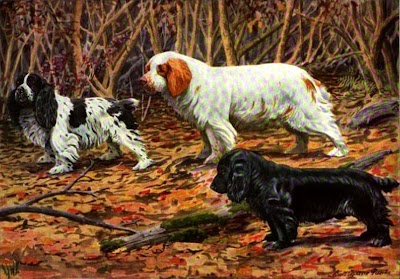 | These rather closely related dogs may, like the setters, be considered each in relation to the others. The clumber is the largest, weighing up to 65 pounds, though the average is probably about 50. |
except for lemon or orange ears and eye patches, with ticking of the same on forelegs
and as little as possible elsewhere. He is a benign, affectionate creature and very sedate in manners.
As a gun-dog, he is used in England on woodcock, snipe, and other lowland birds, but
he has never been much used or bred in this country. The soft, deep eye shows considerable haw in mature dogs. The coat should be almost perfectly straight, and the tail, belly, and legs, down to the hocks, should be full feathered.
The cocker is the smallest of the three and is an active, playful, intelligent little dog, which takes on the spaniel dignity rather later in life than the clumber and the business like field spaniel. He gets his name, "cocker," from the use to which he was bred in hunting woodcock. They are easily trained to fowling, being already predisposed in scenting out and flushing grouse like birds (including the domestic hen). This tendency is taken advantage of and developed, to force grouse up into the trees, where they are easily shot.
The cocker rushes his bird and then barks and keeps it busy and preoccupied. If the hunter himself flushed the game, it would go far and probably not again be seen. The cocker should weigh from 18 to 24 pounds. In color he may be black, red, liver, or lemon, with or without white. These colors should be clear and pronounced, not pale or washed out, and if predominant over white should be virtually solid, the white being restricted to a mere dash on the chest.
If white predominates, the color should be solid on ears and face, except for the fore face and a blaze up the nose. In this case, color should be distributed about as in the English setter. The ears, while long, silky, and set low, should not reach beyond the nose when drawn forward. The legs must be strong, straight, and of good bone and not too short, and the squarely built body hard and muscular. They are admirable house-dogs, but when kept as such should be rather sparingly fed and kept in good trim. A fat spaniel is not an attractive object.
The field spaniel is much larger and stronger than the cocker, but not so restless. He is, however, more active and lively than the clumber. While not so thoughtful looking and sedate as the latter, he is highly intelligent, good natured, and obedient. His body is long and low, but he carries his head with an air of courage and determination. His coat is straight and silky, and his color may be solid black, solid liver, liver and white, black and white, black and tan, orange, or orange and white. The black and the liver are the colors preferred. The proper weight is from 30 to 45 pounds.
From The Book of Dogs: An Intimate Study of Mankind's Best Friend By National Geographic Society (U.S.), Louis Agassiz Fuertes, Ernest Harold Baynes Published 1919. 109 pages Original from Harvard University.
This image (or other media file) is in the public domain because its copyright has expired.
This applies to the United States, where Works published prior to 1978 were copyright protected for a maximum of 75 years.
See Circular 1 "COPYRIGHT BASICS" from the U.S. Copyright Office. Works published before 1923 are now in the public domain In the United States,
This inage is also in the public domain in countries that figure copyright from the date of death of the artist (post mortem auctoris in thi case Louis Agassiz Fuertes (1874 – 1927) and that most commonly runs for a period of 50 to 70 years from that date. If your use will be outside the United States please check your local law.
Tags: Public Domain Clip Art and clip art or public domain and Cocker Spaniel or Clumber Spaniel and Field Spaniel















1 comment:
I like black Cocker Spaniel better. The only thing I see about this breed is their laziness. My pup spends most of the day in bed rather than playing around.
Post a Comment